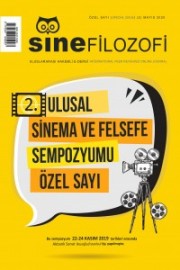Sinema - Bilim - Felsefe Triyalektiği: Kuantumun Çoklu Referans Sistemi ve Sinematik Anlatıya Yansımaları
Cinema - Science - Philosophy Trialectics: Multiple Reference System of Quantum and its Reflections on Cinematic Narrative
Author(s): Ezgi TokdilSubject(s): Philosophy, Recent History (1900 till today), Film / Cinema / Cinematography
Published by: Serdar Öztürk
Keywords: quantum field; cinematographic narrative; uncertainty principle; experimental film; modern cinema;
Summary/Abstract: In this research, quantum physics, which covers the period of ordinary scientific activities about the definition of the micro world and its main theories and principles in the definition of the universe are analyzed by analyzing experimental film since the 1920s and its reflections on modern cinema since the end of the 20th century. In this respect, both the reflections of scientific reality in the context of cinema (the developmental aspect of science changes the narrative forms of cinema), the technological possibilities affect the changing language of the changing world in terms of cinematic philosophy, and the basic principles and discourses of the quantum field on the parallel discourse on cinematic thought and/or cinematic image. to examine the image properties. In order to define and understand this parallel relationship, a comparative analysis is performed on the films taken in order to understand how cinematic thought interprets the scientific mind, how the interpretation is made, the boundary of the real line in cinema philosophy and the paradigm shift as a whole. is being analyzed. Lev Kuleshov, Vsevolod Pudovkin, David W. Griffith, Sergei Eisenstein and Dziga Vertov use the montage technique, Ballet Mécanique (1924), directed by Fernand Leger and directed by Hans Richter, Man Ray and Viking Eggeling's experimental cinema examples, Duchamp's contributions to cinema, Jean-Luc Godard's Breathless (1960), Paul Thomas Anderson's Magnolia (1999), Butterfly Effect (2004), Another Earth, JJ Abrams, Alex Kurtzman and Roberto Orci's science fiction series Fringe (2008-2013) and the 1999 film Matrix and the 2014 Interstaller are considered as films that illustrate the reflections of scientific development and the fundamental principles and approaches of quantum to the cinema. The reality approach in these films is; It is the product of a new consciousness that has been freed from Newtonian assumptions under the influence of the great changes in every field since the beginning of the 20th century and has stepped into a reality that can be defined in multiple reference systems with relative universe understanding.
Journal: SineFilozofi
- Issue Year: 5/2020
- Issue No: Sp. Iss
- Page Range: 370-390
- Page Count: 21
- Language: Turkish

